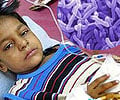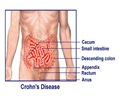Traveler’s diarrhea is commonly caused by bacterial contamination of food and water. Adequate hydration and sometimes antibiotics are used to treat traveler’s diarrhea.

The risk for contacting traveler’s diarrhea depends not only on the region visited but also on the traveler. For example, people suffering from low immunity, inflammatory bowel disease or diabetes are more prone to develop traveler’s diarrhea. Excess alcohol consumption may also be a predisposing factor.
Traveler’s diarrhea usually spreads through contaminated food and water. Thus, a judicious choice of food could help to reduce the chances of contacting the infection. Foods that should preferably be avoided are raw foods, moist foods served at room temperature or unpasteurized dairy products. On the other hand, safer foods include hot, freshly cooked and dry foods, fruits that can be pealed, food that is self washed and prepared, or food with high sugar content. Bottled sealed water from reputed brands or carbonated drinks are usually safe.
Symptoms of traveler’s diarrhea are usually limited to the digestive tract with passage of 3 or more loose stools in 24 hours, abdominal pain, nausea, loss of appetite, vomiting and bloody stools. Traveler’s diarrhea may be accompanied by a low-grade fever. Symptoms usually last for 3 to 5 days.
If symptoms last for more than 14 days, the condition is called persistent traveler’s diarrhea.
How does one prevent traveler’s diarrhea? The best way is to be aware of the condition, and this is possible through appropriate patient education. One simple advice given to travelers regarding food is “Boil it, cook it, peel it, or forget it.” However, not all travelers manage to adhere to all the eating recommendations in a new place.
Bismuth subsalicylate can prevent traveler’s diarrhea when taken for up to 3 weeks, but it does have side effects and cannot be used in all patients. Similarly, antibiotics to prevent traveler’s diarrhea are not routinely recommended due to chances of side effects and the possibility of development of antibiotic resistance. They may be considered in some cases like in people with reduced immunity, chronic intestinal conditions, or those on a very important trip who cannot afford to fall sick, like a business trip or an important athletics meet. In these cases, ciprofloxacin with rifamixin is usually advised.
Antibiotics are used for moderate-to-severe cases that do not respond to symptomatic treatment. Fluoroquinolones like ciprofloxacin and levofloxacin may be given for 3 days. Azithromycin or rifamixin may be useful in some cases.
Drugs that reduce motility like loperamide may be given along with the antibiotic especially while travelling. They should however be avoided in complicated cases associated with fever or bloody stools.
Thus, traveler’s diarrhea may be prevented by taking adequate precautions while eating and drinking in a foreign place. Treatment with rehydration and sometimes antibiotics helps to control the condition.
Reference:
1. Approach to Treatment and Prevention of Traveler’s Diarrhea; Sean Nguyen et al; US Pharmacist 2011
Source-Medindia














